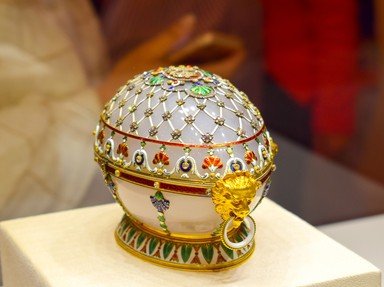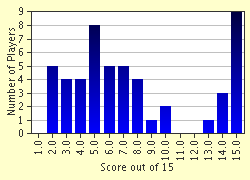Quiz Answer Key and Fun Facts
1. These questions are about the Imperial Eggs in chronological order. The first egg in this quiz was presented by Czar Nicholas to his wife in 1904. It is the largest of the Imperial eggs at 14 1/2 inches. It is also probably the most architectural of all the eggs. It represents the church in the Kremlin that is the traditional site of the coronation of the Czars. What is the name of this church?
2. Czar Nicholas presented his wife with "The Colonnade Egg", probably in 1905. This exquisite composition in pink and green is named for the six Ionic columns which support a classical entablature which in turn carries the egg. What does this beautiful work of art probably commemorate?
3. The Rose Trellis Egg is "one of the prettiest, most feminine in the entire range of the Imperial Easter Eggs". What color of translucent enamel forms the background for the decoration?
4. The egg presented to the Czarina Alexandra in 1908 is another stunning creation. It is carved from dark green nephrite jade; rather than being applied, as in many of the eggs, the decoration here is carved and inlaid into the stone itself. The surprise inside is a stunning miniature copy of the home of Nicholas and Alexandra. What is the name of the palace and the egg which contains its facsimile?
5. About 1909, the Czar presented a rock crystal egg containing a gold model of "The Standart" to his wife. The egg is of an elegant lapis blue, white and crystal color scheme. What was "The Standardt"?
6. In 1910, Czar Nicholas presented an egg of rock crystal to his mother marking the unveiling of a statue of his late father, Czar Alexander III (a sculpture much less inspired than the egg created to commemorate it). In color it is one of the most subdued eggs. As the transparent crystal is colorless, the only color in the egg itself is the metal of its mounts set with diamonds. In what metal is "The Alexander III Equestrian Egg" mounted?
7. The egg presented to Alexandra in 1911 is one of the most intricate. It is decorated with eighteen delicately painted panels: seven portraits of the Imperial couple and their five children , nine scenes of significant events and two dates. This commemorates what Imperial anniversary?
8. Czar Nicholas' gift to his mother, the Dowager Empress, in 1911 is one of the most original in concept. An orange tree with nephrite jade leaves and white enamel flowers, bearing fruit of faceted gems; pink diamonds, amethysts, and citrines, grows from a white agate planter. When the correct gem/orange is pressed the surprise is revealed, what is it?
9. 1912 was the centennial of the Russian victory over Napoleon and his forces at the battle of Borodino. For this anniversary, Nicolas presented his mother with one of the more overtly military eggs, the Napoleonic Egg. The surprise in this egg is a folding screen of six panels of elongated octagons painted by the talented Zuiev. What do the miniatures depict?
10. The next egg, presented to the Empress Alexandra, is yet another anniversary egg. 1913 was the tercentenary (three-hundreth anniversary) of the accession of the House of Romanov to the Throne of Russia. On the exterior of the egg are eighteen miniatures of the Romanov Czars, from Alexis I to Nicholas II. What is the surprise inside this lavish egg?
11. In 1914 Empress Alexandra was presented with an egg absolutely unique among the Imperial gifts. Set with myriad stones; rubies, sapphires, diamonds, emeralds, garnets, topazes, and quartzes, it is called The Mosaic Egg, but might more accurately be compared to what sort of fine needle work?
12. The last peacetime egg given by the Emperor to his mother, in 1914, is the Cameo egg, named for the allegorical paintings on the panels, painted in shades of pale pink and white on a darker pink background to imitate a shell cameo. Though it is separated from the egg, the surprise that came in this can be identified. According to a letter from the Dowager Empress to her sister, Queen Alexandra of England, what was the tiny automaton inside the egg?
13. In the summer of 1914, Russia entered World War One and the last of the Imperial eggs represent this. In 1915 Nicholas presented his mother, dowager Empress Maria, with the Red Cross Egg. What is true of this egg and all the wartime eggs which makes them unique among the eggs represented in these quizzes?
14. World War I raged in 1916, and the Steel Military Egg, presented by the Czar to his wife, reflects these changing times, not least by its rather militaristic basic material, enhanced, but hardly softened by golden decoration. But the most war-like parts of the composition are the supports which carry the egg above the dark green jade base. What are these four pieces, representing the changing face of war?
15. The last known imperial egg is the Cross of St. George Egg of 1916. Commemorating the military decoration awarded for bravery on the battlefield, it is the only egg to known to have left Russia with its original recipient, the Dowager Empress Maria, Nicholas' mother and Alexi's grandmother. Why did Maria retain it alone?
Source: Author
griffinj
This quiz was reviewed by FunTrivia editor
agony before going online.
Any errors found in FunTrivia content are routinely corrected through our feedback system.

